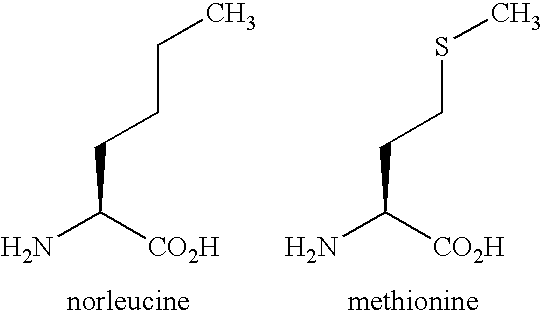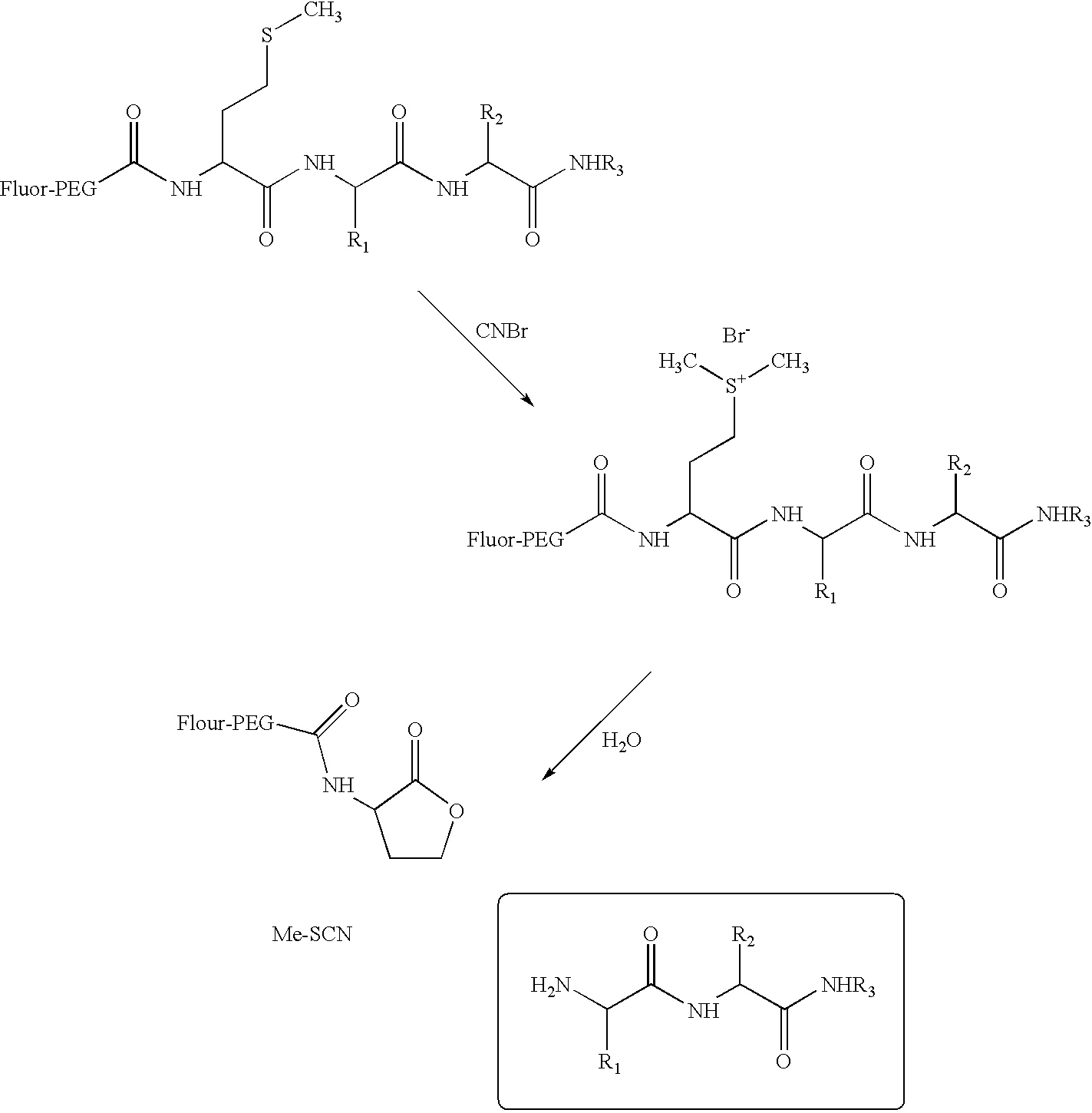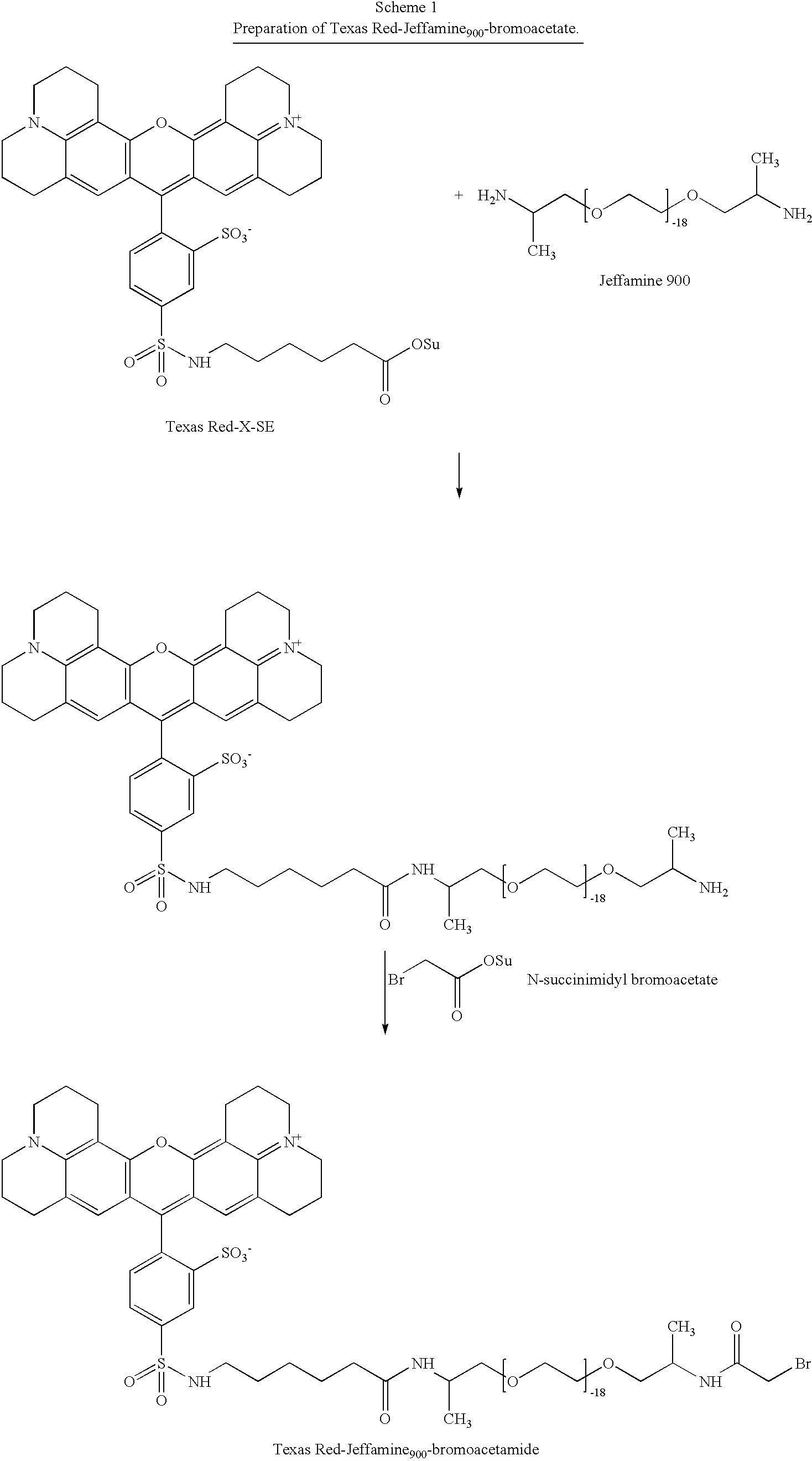Water-soluble, fluorescent, & electrophoretically mobile peptidic substrates for enzymatic reactions and methods for their use in high-throughput screening assays
a technology of peptidic substrates and enzymatic reactions, applied in the direction of peptides, peptide/protein ingredients, instruments, etc., can solve the problems of high cost of radiolabeled reagents, long shelf life of expensive radiolabeled reagents, and inability to adapt to high-throughput assay systems
- Summary
- Abstract
- Description
- Claims
- Application Information
AI Technical Summary
Problems solved by technology
Method used
Image
Examples
example 1
Preparation of Fluorescent Peptide Derivatives for Comparison With The Peptidic Substrates of The Invention
[0154] Fluorescent derivatives of LRRASLG [SEQ. ID NO. 10] (Kemptide) were prepared with Texas Red-X, SE and Kemptide. Kemptide (2.4 mg) was dissolved in 300 .mu.L of 100 mM sodium phosphate, pH 7.0. Texas Red-X, SE (5 mg) was dissolved in 300 .mu.L of dry acetonitrile, and this solution was added to the peptide solution. The reaction proceeded at room temperature for 6 h. Two isomers of the desired product were isolated by reversed-phase high-pressure liquid chromatography (RP-HPLC).
[0155] The fluorescent peptides were assayed with protein kinase A (PKA) using the PepTag assay kit from Promega (Madison, WI). The concentrations of the peptides in the assay were 60 .mu.M, and the concentration of ATP was 1 mM. After completion of the assay the 25 .mu.L reaction mixtures were spiked with 5 .mu.L of 50% glycerol and submitted to gel electrophoresis in a 0.8% horizontal agarose sla...
example 2
Preparation and Characterization of Fluorescent Jeffamine.sub.900 Derivative Peptide Substrates
[0156] An active-ester derivative of BODIPY TRX-SE was conjugated to the PEG by reacting with .alpha.,.omega.-diamino PEG (Jeffamine ED-900). The reaction proceeded at room temperature in acetonitrile at a ratio of ten moles of Jeffamine ED-900 per mole of fluorophore. After the fluorophore active ester was consumed completely, twenty equivalents of N-succinimidyl bromoacetate per equivalent of amine was added to the reaction mixture, according to Scheme 1, below: 3
[0157] After the reaction was completed, the fluorophore-PEG-bromoacetamid-e was purified by liquid chromatography. The thiol-containing peptide CEEEFIYGAFKKKK [SEQ. ID NO. 8] was subsequently treated with the fluorophore-PEG-bromoacetamide to produce the fluorophore-PEG-peptidic substrate, as shown in scheme 2, below. This product was also purified by liquid chromatography. 4
[0158] An assay of the fluorescent peptidic substrate...
example 3
Preparation and Characterization of Fluorescent PEG.sub.3400 Derivative Peptide Substrates
[0159] In another example the fluorophore BODIPY.sub.630 / 650 was coupled to the synthetic peptide LRRASLG [SEQ. ID NO. 10] (Kemptide) employing a 3,400 molecular weight PEG spacer. When a conjugate comprising just the BODIPY.sub.630 / 650 and Kemptide was made, its solubility was so low that Protein Kinase A could not phosphorylate it.
[0160] Because Kemptide already possesses good solubility and charge characteristics, and because the n-terminal lysine is useful for coupling reactions, no further modification of the peptide sequence was necessary. The PEG.sub.3400-BODIPY.sub.630 / 650 conjugate was prepared from H.sub.2N-PEG.sub.3400-CO.sub.2H (Shearwater Polymers, Inc.) and BODIPY.sub.630 / 650 X-SE (Molecular Probes) in acetonitrile. The product was purified on reversed-phase HPLC. BODIPY.sub.630 / 650-PEG-CO.sub.2H was activated with three equivalents each of EDCI and NHS in 50 mM MES, pH 5.5 for on...
PUM
| Property | Measurement | Unit |
|---|---|---|
| molecular weight | aaaaa | aaaaa |
| molecular weight | aaaaa | aaaaa |
| molecular weight | aaaaa | aaaaa |
Abstract
Description
Claims
Application Information
 Login to View More
Login to View More - R&D
- Intellectual Property
- Life Sciences
- Materials
- Tech Scout
- Unparalleled Data Quality
- Higher Quality Content
- 60% Fewer Hallucinations
Browse by: Latest US Patents, China's latest patents, Technical Efficacy Thesaurus, Application Domain, Technology Topic, Popular Technical Reports.
© 2025 PatSnap. All rights reserved.Legal|Privacy policy|Modern Slavery Act Transparency Statement|Sitemap|About US| Contact US: help@patsnap.com



